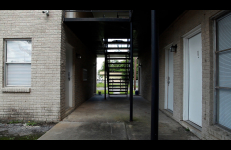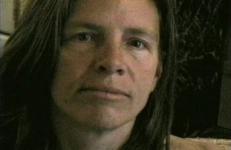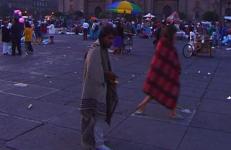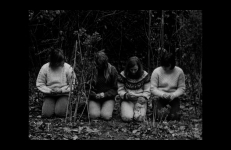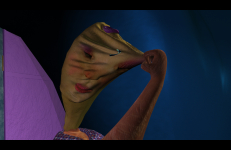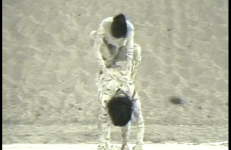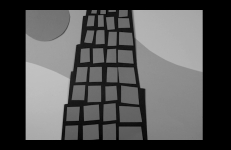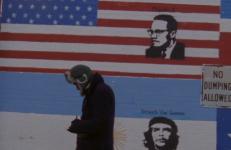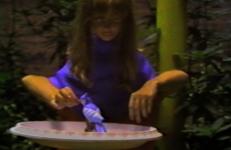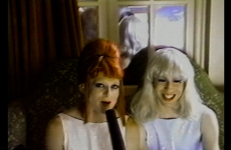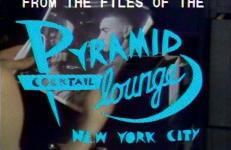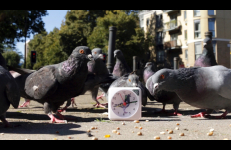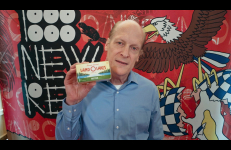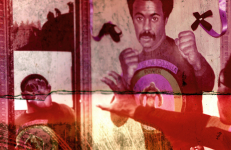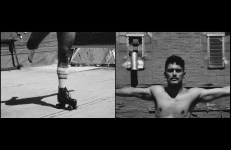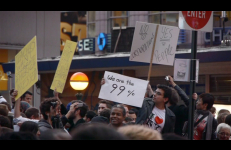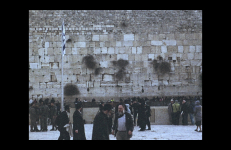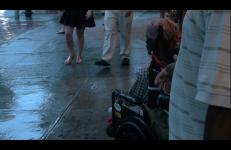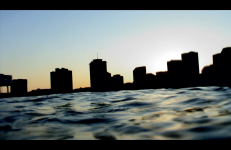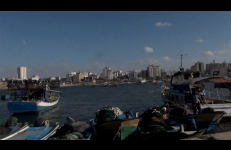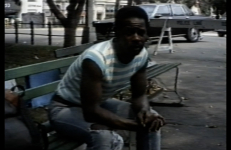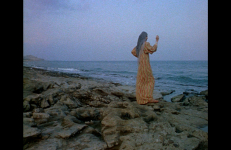From below ground, a man named Eddie describes flood lines, levees and trivial histories of the crumbling infrastructure of Memphis, TN. In this same city, the filmmaker, a recent transsexual transplant, watches military propaganda and contemplates masculine connectivity as he attempts to integrate into the American South. He posts a Craigslist ad asking men to masturbate on-camera with their firearms. He receives a single response from a man whose name is also Eddie.
City
This video is an unabashed fan letter to poet Eileen Myles. As in Laurie, my desire was to romanticize the poet, but not through her writing so much as through her reputation as the natural born child of the New York School and the Beats. I shot the movie as I imagined Robert Frank and Alfred Leslie shooting Pull My Daisy, a film that left an impression on me chiefly of the struggle between form and formlessness, plan and improvisation, sketch and story.
El Zócalo is an observational portrait of Mexico City’s central Plaza de la Constitutión during one day in August. Soldiers, Aztec dancers, clowns, food vendors, protestors, rain, dogs, tourists, kites, balloons, and dignitaries all meet in the public space of the Zócalo. This documentary presents daily life in one of the largest and most vibrant urban centers in the world, but it begins with a dream of history and ends with a dream of the space full of people for a Zapatista rally.
El Zócalo is an observational portrait of Mexico City’s central Plaza de la Constitutión during one day in August. Soldiers, Aztec dancers, clowns, food vendors, protestors, rain, dogs, tourists, kites, balloons, and dignitaries all meet in the public space of the Zócalo. This documentary presents daily life in one of the largest and most vibrant urban centers in the world, but it begins with a dream of history and ends with a dream of the space full of people for a Zapatista rally.
Elle is an experimental dance film shot in a semi industrial landscape in Brooklyn reflecting on every day movements of falling and getting up.
Cinematography: Carolyn MaCartney
Choreography: Eleanor Hullihan and Katy Pyle Dancers, Eleanor Hullihan, Katy Pyle, Beth Gill, Emily Wexler Music, Zeena Parkins
Editor: Geoffrey Pugen
An animation that combines narrative experimentation with the abstraction of motion capture about two groups of misfit hackers in a city of traffic. They speak a language of advertising, corporate branding and self-help, while engaging in a battle to control traffic lights. The discovery that the entire social code is embedded in the access code that regulates traffic lights, begins a twisted ride of cultural espionage techniques. These techniques include surveillance cameras and costumes, as they attempt to untangle the social codes of characters caught in an endless rush hour.
Event Fission is an outdoor performance on the Hudson River landfill, produced by Creative Time. Eiko & Koma danced with a huge white flag billowing on top of a sand dune as the audience watched from below. The white flag was used to symbolically attack the newly developed downtown buildings. On a lower level of the landfill, to which Eiko & Koma tumbled down, there were fires on four corners of the performing area. At the end of the performance of 50 minutes, Eiko & Koma were swallowed into a deep hole they had dug and hid, disappearing with a blast of sand.
Failing Up describes career advancement despite bad decisions, bankruptcies, and intellectual mediocrity. In this short film, the Manhattan real estate holdings of the King of Failing Up are catalogued and synced to a soundtrack that suggests how it feels to be one of his subjects.
Whip pans, zooms, lens twists, and bursts of stop-frame animation transform eight minutes of borrowed audio from Home Alone 2 (a film that features a cameo of the current US President) into a political work of slapstique concrete.
The Diaspora Suite
Filmed on location in Harlem (NY) and Ethiopia, Forged Ways oscillates between the first person account of a filmmaker, a man navigating the streets of Harlem, and the day to day life in the cities and villages of Ethiopia.
This first "Frieda" collaboration between performance artists Barbara Lipp and Tom Koden and video artist Tom Rubnitz chronicles Frieda's rise from assembly-line worker in a box factory to singing superstar. Featuring rock-bottom production values and a sound track which includes the Brady Bunch kids' tune "Gonna Find a Rainbow".
This first "Frieda" collaboration between performance artists Barbara Lipp and Tom Koden and video artist Tom Rubnitz chronicles Frieda's rise from assembly-line worker in a box factory to singing superstar. Featuring rock-bottom production values and a sound track which includes the Brady Bunch kids' tune "Gonna Find a Rainbow".
This first "Frieda" collaboration between performance artists Barbara Lipp and Tom Koden and video artist Tom Rubnitz chronicles Frieda's rise from assembly-line worker in a box factory to singing superstar. Featuring rock-bottom production values and a sound track which includes the Brady Bunch kids' tune "Gonna Find a Rainbow".
In From Fagtasia to Frisco, Brenda and Glennda report from Fagtasia, an event honoring the Summer Solstice in New York organized by the Radical Faeries. Through interviews with Faeries and footage of their walk across the Brooklyn Bridge, the group proposes to reclaim the city as a safe space for queer people, and discuss reorienting queer consciousness toward spirituality.
From The Files of the Pyramid Cocktail Lounge is a series of video clips taken at the Pyramid Club, a seminal location for the East Village drag scene in the midst of the club's most influential years. While rummaging through a file cabinet full of event fliers from the Pyramid Club, an office worker in drag guides the viewer through video documentation of past performances at the club.
Using the Islington Gazette and local pigeons as my guides I strolled, re-strolled, and strolled some more along the Essex Road: updown, downup. Paving stones, buses. Railings railings railings. More buses. Abandoned dummies and mystery blotching on the concrete – is that gum or lichen? – as shadows sundial the day away.
A combination of live action, stop motion and table top animation – my contribution to Essex Road IV draws on the glee of motion through cinematic artifice: a 25 fps flick book of a film.
Swerving between branded content, documentary, and a decolonial episode of MTV 'Cribs', the film revolves around a tour of an apartment which has supposedly been given back, led by reformed Native American impersonator, and frequent New Red Order collaborator, Jim Fletcher, alongside profiles of real individuals involved with the voluntary return of land to Indigenous peoples, organizations, and tribes. The film continues New Red Order's ongoing research into instances of settlers returning land to Indigenous peoples, a practice that has been growing exponentially over the past decade.
Go-Rilla Means War is a filmic relic of gentrification featuring 35mm film salvaged from a now demolished Black Civil Rights Theater in Bedford-Stuyvesant, Brooklyn. After finding the film unfinished and un-canned on the floor of The Slave Theater, Campbell collaborated with the unknown director (presumably amateur filmmaker Judge John Phillips who owned the Slave Theater) to finish the film.
A film titled Dance Movie (or, alternatively, Rollerskate) appears in many Warhol filmographies, but no work with this title has been found in the archive. The lost film, starring dancer Fred Herko, was shot in 1963. A year later, Herko leaped out of an open window while dancing to Mozart’s Coronation Mass in C Major. Inspired by descriptions of the missing film and the memoir of Herko’s best friend, the poet Diane Di Prima, Goddess of Speed poetically reimagines the last days of the young performer.
Gravity Hill Newsreels: Occupy Wall Street comprises Jem Cohen’s twelve-part series as a continuous and complete compilation. Cohen, who witnessed the New York occupation from day one, borrowed a digital camera and started gathering footage in subsequent weeks. Initially acting upon an instinctive impulse to document and be guided by the events of the movement through quiet participation, Cohen’s documentation took a more public and expansive form through an agreement with the IFC Center, a local movie theater.
ḤARAM is an essay film portraying the urgent contemporary situation at the Haram Al Sharif/ Noble Sanctuary in the Old City of Jerusalem reflecting on the growing Temple Mount Faithful movement whose goal is to build the Jewish Third Temple on this holy landscape and in turn to assert Jewish sovereignty over this holy Muslim site.
Director and Editor: Cynthia Madansky
Cinematographer: Michele Paradisi
With Nazmi Al Jubeh and Avital Itzhak
Sound Design: Binya Reches
Graphic Design: RRNR Studio
There is no better place to meet people than in the temporary community which gathers under a scant awning on a New York street in a downpour.
High Water was filmed in post-Katrina New Orleans and the surrounding Louisiana wetlands, one of the fastest disappearing coastal areas on the planet. The work engages viewers in a contemplation of a landscape damaged by human intervention that nevertheless struggles to retain its vitality. High Water is accompanied by Stephen Vitiello’s moody soundtrack.
Music by Stephen Vitiello
Gian Pablo Villamil, technical/creative consultant
Denise Markonish, MASS MoCA, producer
Kenneth Terry, trumpet player
Home Movies Gaza introduces us to the Gaza Strip as a mircrocosm for the failure of civilization. In an attempt to describe the everyday of a place that struggles for the most basic of human rights, this video claims a perspective from within the domestic spaces of a territory that is complicated, derelict, and altogether impossible to separate from its political identity.
"... Basma Alsharif’s Home Movies Gaza, a film that captures the impossibly politicized domestic sphere of the Gaza Strip, under the constant hum and buzz of overhead drones."
In her video Homeward Bound, Bear documents the Homeward Bound Community Services, a group of self-supporting homeless citizens who gathered at City Hall Park in 1988 to protest New York City’s housing policies and Mayor Ed Koch’s lack of support for the homeless community.
I Have Always Been A Dreamer is an essay film about globalization and urban ecology using the examples of two cities in contrasting states of development: Dubai, UAE and Detroit, U.S.A. Within the context of a boom and bust economy, the film questions the collective ideologies that shape the physical landscape and impact local communities.




